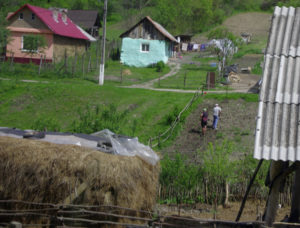St Lawrence’s Church is set above the main road through Thornton Curtis and is an attractive building with a long nave and chancel and sturdy square tower. The church was attached to nearby “Thornton Abbey”:http://wasleys.org.uk/eleanor/churches/england/ruined_abbeys/midlands_south/thornton_abbey/index.html and is much larger than needed by the present village.
Little is known about the early history of the church and it is not mentioned in the Domesday book. The chancel is the oldest part of the church and dates from the C12th. The porch and tower are C14th and the rest of the church is C13/C14th. It was restored at the end of the C19th, when the chancel and nave were reroofed, windows and buttressed repaired and heating installed. The vestry was turned into the organ chamber.
The C12th wooden door with its wrought iron hinges still survives. Entry is through a smaller door set into it.
At the back of the church is the C12th Black Tournai Marble font. These were carved in Belgium and traded throughout western Europe. There are only seven still surviving in England including one at “Lincoln Minster”:http://wasleys.org.uk/eleanor/churches/england/lincolnshire/lincolnshire_three/lincoln_cathedral/cathedral_three/index.html . All are a similar style with a large square bowl, thick central column with four narrower corner shafts. The font has been restored recently and is splendid. There are beasts and birds carved round the outside of the bowl.
It is an attractive church with an arcade of pointed arches separating the nave from the side aisles. The north arcade is plainer and may be later than the south arcade. A pointed arch leads into the base of the tower. Above it is the Royal Coat of Arms of George III.
Walls are plastered and the roof dates from the 1880s restoration. The pews date from then, although the pulpit is Jacobean. The beautifully carved rood screen, with its open fretwork top, is C19th.
There is a simple C17th table altar at the east end with a blind stone arcade behind it. Set in the floor behind the altar table is the original stone Mensa. This was used to celebrate mass before the Reformation. This is a rare survival as most were destroyed. The five small carved crosses representing the five wounds of Christ can still be seen at the corners and in the centre.
Tucked away in the vestry behind the organ is one of the original strong boxes from the church.
The now by the south door into the church was originally in the chancel. It was moved to its present position during the C19th restoration . He died aged 33 and was “rarely adorned with special gifts and endowments of mind and singular ornaments of body”.
This is a very attractive church and well worth visiting. It gets few visitors. It is only open the first Wednesday of the month, although there is a key holder in the village. There is plenty of parking in the village. The post code is DN39 6XJ and the grid reference is TA 088179.
There are more pictures “here.”:http://wasleys.org.uk/eleanor/churches/england/lincolnshire/lincolnshire_five/thornton_curtis/index.html








